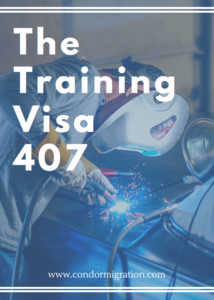Understanding The Training Visa 407 And Its Benefits

This post reflects the legal landscape as of the date of publication. Laws may have changed since then. Please consult a legal professional for current information and personalised advice.
The training visa is exempt from the skills fund donation, doesn’t have the two-year work experience requirement and has one of the lowest visa application fees. There even are no minimum salaries required by the Department. On face value this visa looks like the perfect solution. Sometimes it is, but important to note is that it is not as easy as it seems.
It used to be that students would often leave their studies early and jump into a 457 visa. This visa has now been replaced by the 482 which comes with a minimum 2 years work experience requirement. That coupled with the expensive skills fund donation required by the employer means this visa is harder and harder to get and in all likelihood is out of reach for most student visa holders. A possible alternative is the 407 training visa.
This visa requires you to have some experience in a skilled occupation on the long term list but acknowledges that your skills still require development. As we know a career is not made overnight and you need exposure to new challenges and opportunities to improve your skillset. On the job training is one of the ways to improve your skillset and this is acknowledged by the Department.
So, how does the training visa work?
Like the 482, it comes in 3 stages: Sponsorship, Nomination and Application.
Sponsorship: $420 must be paid by the employer and essentially is designed to ensure the business is actively and lawfully operating
Nomination: $170 must be paid by the employer. This nomination is different to any other you have seen before. It is not about proving the need for an employee but rather it is about demonstrating the skill level of the employee/trainee and specifically explaining how a period of sponsorship with the business (up to two years) will enhance the pre-existing skills of the person who wants to apply for the visa. To demonstrate pre-existing skills, one year work experience is required.
The visa is also available for those who need practical hours in order to register for an occupational license etc.
Whilst there is no minimum salary dictated by the Department employers must nonetheless comply with other State/Federal laws and an Award dictating a minimum salary may apply.
Application: The primary visa grant holder can only work with their sponsor. Their spouse will have 20 hours of work rights per week. If the training plan etc. have been drafted properly time on the training visa may help the visa holder gain points for the 189/190 permanent residency skilled visas.
Some occupations are better suited for this occupation than others and the training plan submitted to the Department is the crucial element that determines approval or rejection.
In terms of professional fees, you can expect to pay similar to what you would for a 482, even though it is a shorter visa it is much more complex.
If you think your employer might be willing to sponsor you knowing that the $73,150 p.a. isn’t required, feel free to get in touch for a one-on-one assessment of your case.
